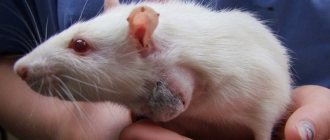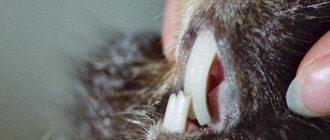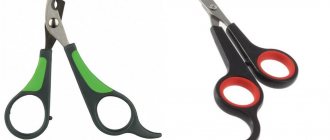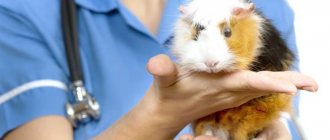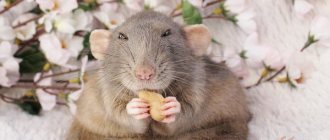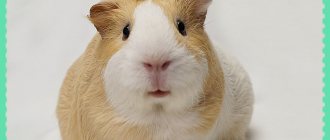Information / Excessive tooth growth in chinchillas - malocclusion
What are the problems with chinchilla teeth?
There are twenty teeth in the chinchilla's mouth - 4 front incisors and 16 molars. You can see the front incisors with your own eyes by pulling back the chinchilla’s front and lower lips. The molars are located deeper in the mouth and can only be seen using a special medical device called an otoscope (a funnel with a built-in LED).
Why do chinchilla teeth grow quickly? Because rodents eat dry and solid food. The mechanism of rapid tooth growth is laid down by evolution. Imagine that a chinchilla's teeth grow just like a person's fingernails. A person regularly trims his nails with scissors, otherwise they will grow so long that they will not allow him to work with his hands. A chinchilla cannot “trim” its own teeth; it wears them down by chewing hay, wood, a grindstone and everything else that comes “to the tooth” - a rodent is a rodent.
Teeth regrowth occurs if the chinchilla’s diet does not contain enough roughage and solid food - hay, chewing sticks, whole grains. The teeth grow long, become hooked, and injure the tongue and cheeks. The animal is unable to close its mouth, cannot chew food and dies from hunger. However, do not be discouraged, the problem can be prevented and successfully treated, especially in the early stages.
Causes
The causes of dental diseases can be hereditary, related to the structural features of the bones of the skull and teeth, or acquired.
Acquired ones include, first of all, improper feeding. In nature, rodents and lagomorphs feed on tough grasses, leaves and bark, which ensure uniform grinding of teeth. At home, owners often offer their pet what they think it likes best - juicy and soft food. An imbalance between rough and soft foods often leads to the formation of malocclusion and malocclusion, when teeth stop wearing properly.
Other causes of dental diseases include disturbances in calcium-phosphorus metabolism, trauma to the teeth and jaw, abscesses and tumors. In addition, malocclusion can occur as a result of refusal to eat in the presence of other diseases. Rodents and lagomorphs very often refuse food completely or partially if they experience pain or discomfort. Sometimes a few days of not eating is enough for the bite to become disrupted.
Chinchilla dental diseases, their symptoms and treatment
Chinchillas are prone to developing a wide range of dental pathologies. The most common are:
- malocclusion;
- caries;
- resorption (destruction) of teeth;
- root elongation;
- excessive growth.
To prevent disease, provide your chinchilla with access to young branches of a pear or apple tree (for chewing), as well as hay. Another useful item is a piece of pumice. It also sharpens teeth well.
How can you tell if your pet has dental problems?
Here are some signs that may indicate dental problems:
- The animal has become more picky about food, choosing mainly soft food, thin blades of grass, and succulent food. You notice that your pet often rummages in the bowl, tries to get something, but ends up spitting it out - he wants to eat, but cannot.
- The front teeth (incisors) have dark spots, bevels, teeth are excessively long or often break, the upper incisors begin to bend inward or diverge to the sides.
- Wet, sticky hair on the neck and chin indicates hypersalivation (increased salivation), this is a signal that not everything is in order in the oral cavity.
- Loss of body weight. You should weigh your pet regularly. Weight loss may be due to malnutrition associated with the inability to chew food in the required quantity.
- Discharge from the eyes when eating or after eating. Most likely, your pet experiences pain when eating.
- Gurgling, wheezing in the nasopharynx. Often the owner describes these sounds with the word “hrundit”.
- The absence of stool, or unformed, irregular, small stools, indicates malnutrition.
What to do?
First of all, do not try to identify this problem yourself.
When examining an animal at home without special equipment, you will only be able to see the incisors.
Pathology of incisor growth, as an independent disease, occurs mainly in rabbits, hamsters and rats. In guinea pigs and chinchillas, malocclusion of the incisors is less common and, as a rule, is not a reason for food refusal.
A common dental pathology in a young rabbit: the lower incisors protrude in front of the upper ones:
In addition to incisors, guinea pigs, rabbits and chinchillas also have so-called cheek teeth, which are continuously growing - premolars and molars.
If you try to examine your cheek teeth with improvised means, you may injure the oral mucosa. If the restraint is incorrect, the animal will break free and experience stress. But the problem will never be found.
In some cases, a visual examination is not enough to identify dental diseases. Multiple x-rays may also be required. Therefore, it is recommended to carry out the examination in a clinical setting.
X-ray of a rabbit's skull with malocclusion:
To assess the condition of the teeth, take the animal to a specialist who can not only identify the problem, but also, if necessary, correct the bite and give all the necessary recommendations for further care and nutrition.
If the disease is advanced, a single teeth trimming may not be enough. In such cases, bite correction is carried out once every 2-4 weeks, depending on the condition of the teeth - how quickly they grow, until the animal is able to grind down the teeth on its own. Sometimes the bite is restored, but in some cases, due to irreversible changes and/or the presence of concomitant diseases, the animal requires bite correction throughout its life.
Dental examination of a guinea pig: examination of molars and premolars:
Gastric volvulus
The problem is common and often untreatable. An empty stomach with average filling has a volume of 20-40 cm3. and weighs 15 g. When the stomach expands due to overfilling with food masses or gases, its walls become thinner. Baroreceptors react to this, as a result of which the evacuation of food from the stomach into the cavity of the duodenum is reflexively inhibited.
The vessels of the stomach walls are compressed, and blood is redistributed. An enlarged stomach pushes the abdominal organs back and puts pressure on the chest, making breathing difficult. With severe thinning, rupture of the stomach wall is possible at the slightest pressure on the abdominal wall. Excessive gas formation is observed when feeding low-quality fermented food, cabbage or legumes.
Clinically, one can note an increase in the volume of the abdominal wall, rapid breathing, cyanosis (cyanosis) of the mucous membranes of the head, apathy, immobility, and impaired defecation. If at least some signs are observed, you should immediately contact veterinary specialists. With this pathology, death occurs in the absence of help within 24 hours. Therapeutic assistance boils down to the administration of carminative and antifoaming drugs, massage, and, if necessary, probing and subcutaneous administration of crystalloids and nutrient solutions. Mortality – 90%.
How is the bite correction procedure performed?
Often, pet owners worry about how their pets will cope with teeth trimming procedures. I prefer to perform bite correction without the use of anesthesia. The slight stress that an animal may experience during trimming is not commensurate with the stress that your pet experiences with constant pain associated with improper growth of teeth that injure the oral cavity. When correcting the bite, rodents and rabbits do not experience toothache; this manipulation is comparable to trimming their claws, if the doctor has the necessary experience in carrying out the procedure. The procedure itself takes only a few minutes.
Unfortunately, as I said above, it is not always possible to completely eliminate the problem so that bite correction is never required again. If the bite is seriously compromised due to late treatment or improper treatment, further trimming may be required throughout life. Let's imagine that at the age of 2, a guinea pig developed dental problems, and now she will have to trim her teeth 1-2 times a month. Let’s imagine that this pig lives safely for up to 6 years, because it will be taken care of and regularly brought in for bite correction (yes, such animals and such owners really exist!). Over the course of 4 years, you will have to carry out this procedure 50 to 100 times. Regular use of anesthesia for this procedure, even the safest one, can significantly shorten the life of your pet. We are talking about a healthy animal that has no other problems other than dental ones. And if we talk about patients with pathologies of the respiratory system, heart failure, severe liver and kidney diseases, severe exhaustion, anesthesia may be completely contraindicated and lead to death. Therefore, if it is possible to carry out a correction without anesthesia, I always do it. Anesthesia is necessary only in very rare cases.
I perform dental manipulations on chewing teeth using specialized German instruments designed specifically for rodents and rabbits. Unlike Pakistani analogues, non-specialized surgical and manicure instruments, my instruments do not crumble teeth, do not leave cracks in them, do not injure the oral cavity and allow you to achieve the desired result with high precision.
What happens if you don’t seek help in a timely manner?
Sometimes owners hope that dental problems can resolve themselves. Unfortunately this is not possible. Changes occur in the oral cavity that cannot disappear on their own.
The incisors become excessively long and grow incorrectly. The animal is unable to grasp and bite food, which leads to starvation.
The lower cheek teeth begin to grow towards the tongue, and ulcers appear on the tongue from a tooth injury. Over time, the lower teeth completely close over the tongue with a “bridge”, and, as a result, the animal cannot chew, push and swallow food.
Upper molars and premolars tend to grow toward the cheeks. In this case, the sharp hooks injure the cheek and it is painful for the animal to chew. In the places where the hooks dig in, non-healing wounds appear, into which food gets trapped. This can cause abscesses to form.
Significant lengthening of the chewing teeth can lead to dislocation of the jaw, in which case the animal will never be able to eat solid food, and bite correction will be required very often.
Injuries
Often found in free-ranging animals. Due to the animal's mobility and its small size, owners sometimes themselves provoke domestic injuries - compression fractures, bruises, hematomas, fractures of limb bones, damage to the coat. If there are other animals, biting wounds and claw injuries cannot be ruled out.
Surgical treatment of limb fractures is not widely practiced in chinchillas. There are two outcomes of the problem - either self-healing (reparative drugs, vitamins and antimicrobial agents are prescribed in parallel) or necrosis with subsequent death. Due to the low sensitivity of external proprioceptors, chinchillas often chew off injured fingers or the entire paw themselves. In this case, a course of antibiotics, local wound treatments and the prescription of anti-edematous and anti-itching drugs are required.
To avoid injury, the animal must be in a cage. For festivities, a walking plastic ball is used. The animal must be handled with care. Avoid contact with children. Fixation should be carried out by the tail - the strongest part of the animal.
Does malocclusion affect life expectancy?
It does not affect if timely measures are taken to correct the bite. The interval during which the teeth are already growing, but do not yet injure the oral cavity, is empirically selected, and correction is carried out. If the animal does not starve and does not experience discomfort due to overgrown teeth, it has every chance of living to a ripe old age. In practice, I have many patients whose dental diseases appeared at a young age, that is, for more than half of their lives they had their teeth corrected, and this had no effect on their life expectancy, provided the owners were responsible. Most live to a ripe old age, feed independently in the intervals between corrections, eat hay and solid food and live a full, happy life.
Remember, diseases in rodents and lagomorphs progress rapidly. In addition to the oral cavity, digestive problems arise due to dietary disturbances. To prevent this, you need to contact a specialist in a timely manner.
Prevention of malocclusion
In most cases, it is much easier to prevent the development of malocclusion than to treat it. The main preventive measures are proper nutrition for the pet (granulate, stones, twigs - for grinding constantly growing teeth).
Chinchillas need high-quality hay every day: firstly, it is an excellent source of fiber, and secondly, it plays a big role in grinding down the molars.
Granulate is good for grinding teeth, but it is not an alternative to the natural diet of rodents. Therefore, for the best grinding, you should regularly give the animal suitable material for gnawing - twigs of ash, maple, birch, elm, apple, pear, alder, currant, blackberry. A chinchilla's cage must also have a sharpening stone, a mineral stone, and various wooden toys.
In order to prevent the development of oral diseases, it is very important to visit a veterinarian annually (or even better, once every six months).
Share with your friends:


